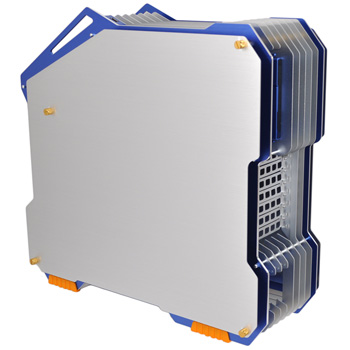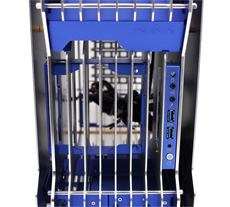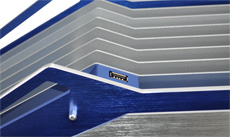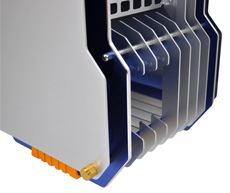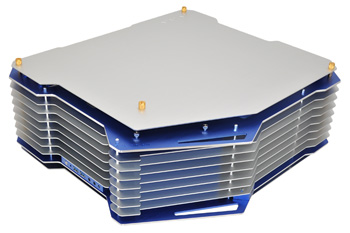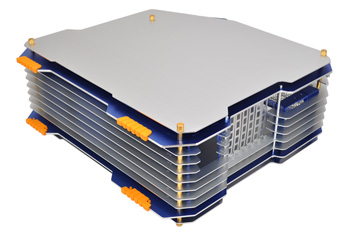Introduction
The HEXUS team has never designed a chassis, but if it did, we reckon it'd look something like this:
What you're looking at is the In Win H-Frame, which, despite the 'H' and the rather-dashing blue-and-orange highlights, is no relation to HEXUS. A shame, really, as our company logo would look pretty damn cool emblazoned across that silver side panel.
Still, it's a beautiful-looking bit of kit, isn't it? Like the compact open-air XFrame, this H variant is designed to stand out from the crowd with a shell that's both eye-catching and open to the elements. Instead of making a traditional box, In Win is using eleven diamond-cut aluminium plates that are held together via steel rods to create a solid structure.
The first question, however, is why? The H-Frame clearly isn't going to protect your components against dust, it isn't going to do much to dampen noise, and if you spill your coffee while you're in the vicinity, it's bye-bye PC. So, again, the question is why? Going by In Win's marketing material, the idea is to create an open-air structure that provides excellent thermal performance from a fan-less design.
We can see the logic - having a fresh supply of air at all times should help lower component temperature - but let's not be under any illusion; the H-Frame isn't designed to offer ground-breaking performance, its primary reason for existence is to look friggin' cool. And in that sense, the H-Frame is a success. Everything from the contrast of blue, silver and orange to the crazy amount of angles and razor-like blades is a visual treat. We see our fair share of chassis in the HEXUS labs, but this one's like nothing we've seen before.
In Win H-Frame |
||
|---|---|---|
| Case Type | Mid-Tower, Open-Air | |
| Material | Aluminium | |
| Colour(s) | Silver, Blue and Orange | |
| Motherboard Support | ATX / Micro ATX | |
| Drive Bays | External | 5.25in x 1 |
| Internal | 3.5/2.5in x 3 2.5in x 1 |
|
| Cooling | Rear | 1 x 120mm exhaust fan (optional) |
| Front | 1 x 120mm intake fan (optional) | |
| Expansion Slots | 7 | |
| Front I/O Ports | USB 3.0 x 2 HD Audio |
|
| Top I/O Ports | USB 2.0 x 1 | |
| Graphics Clearance | 350mm | |
| Power Supply | ATX (not included) | |
| Weight | 7.3 KG | |
| Dimensions | (H) 524mm x (W) 220mm x (D) 545mm | |
But is the H-Frame only unique on the surface? Dig into the specification and it comes across as a distinctly average mid-tower case, which is a concern when you factor in the estimated £300 retail price. The cost is a by product of In Win's manufacturing process - the H-Frame is a limited edition chassis made one at a time by carving out slabs of aluminium - but that doesn't change the fact that for that lofty amount, you get only one 5.25in optical bay, just four hard-disk bays, an average seven expansion slots, and absolutely no bundled fans.
You won't be installing liquid-cooled radiators or massive storage arrays - such luxuries simply haven't been provisioned for - so the H-Frame is relying heavily on visual appeal.
Fortunately for In Win, the H-Frame is sexy from just about every angle. The aluminium blades are all well-built and precise, the blue finish is excellent and even the small touches - like the yellow/orange silicone feet - don't go amiss. The front I/O panel is adequately stocked with a pair of USB 3.0 ports and audio jacks - as well as a disk activity LED that gives an orange glow to match the chassis' feet - and there's an easy-to-reach USB 2.0 port conveniently positioned on top of the case.
The optical drive bay is unusually positioned at an angle - it sort of slopes down toward the ground - and the carry handles (if that's what they're intended to be) are almost entirely superfluous; there's barely enough room for your fingers and the harshness of the metal makes lifting a fully-built rig a painful process. Still, they look cool.
But there is another problem with the H-Frame. It looks gorgeous and it's nicely crafted, but what use is an open-air chassis if you can't see everything that's inside? Earlier prototypes showed the H-Frame with Perspex side panels, but in this final design In Win has opted for solid aluminium sheets. And that's a real shame, as the H-Frame is just as good looking on the inside.







